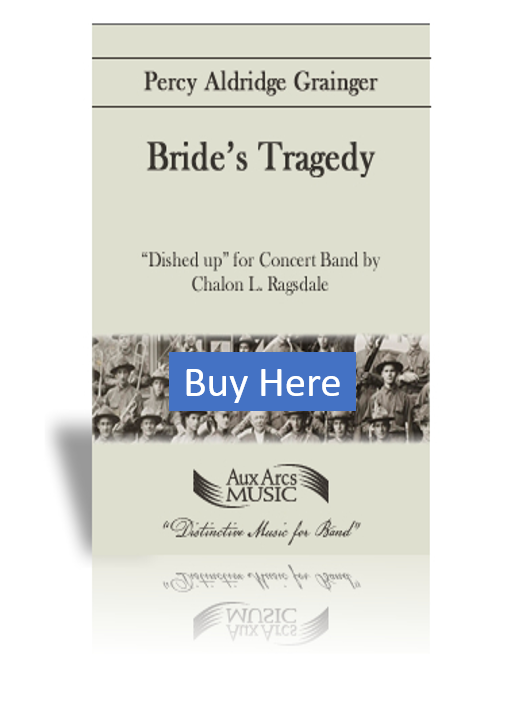The Bride’s Tragedy is a Grade 6, well-suited for the accomplished collegiate wind band. Length 10′.
About the piece:
In a questionnaire competed in the early 1950’s for the volume Musikkens Verden: Musik fra A-Z, Percy Grainger listed The Bride’s Tragedy, a setting of A.C. Swinburne’s “faux border ballad” as among his “most important and characteristic works.”
Grainger expressed an affinity for the Scots border ballads, having set genuine ballads collected by Sir Walter Scott — The Lads of Wamphray and The Twa Corbies, as well as another “faux border ballad” by Swinburne, The Reiver’s Neck Verse.
The Bride’s Tragedy is densely orchestrated, metrically complex (21 meter changes in the first 26 measures) and free in its tonality. The text is an original poem by A.C. Swinburne in the style of a Scots border ballad. It begins:
“The wind wears roun’, the day wears doun,
The moon is grisly grey;
There’s nae man rides by the mirk muirsides [moorside],
Nor down the dark Tyne’s way.” [the Tyne River winds through much of the country south of the Scottish border)
In, in, out and in,
Blaws the wind and whirls the whin [“whin” is a type of evergreen shrub].
The refrain, “In, in, out and in, Blaws the wind and whirls the whin’” is particularly haunting, and is most often scored in this setting for euphonium/trombones.
The dense texture of The Bride’s Tragedy is a major challenge for the wind band and its conductor. Grainger was a believer in what he called “democratic polyphony”:
“I personally, would go so far as to assert that the value of all existing art music depends on the extent to which it is intrinsically many-voiced or democratic — that is to say, the extent to which the harmonic texture is created out of freely-moving voices, each of them full of character, or vigor, or melodic loveliness.”
The vast majority of the musical material in The Bride’s Tragedy is thematic — melodies, countermelodies or bass lines. Virtually none of the material is what one might call “accompaniment,” so sorting it all out to avoid total cacophony can be a struggle. Percy himself said,
“The whole life-giving element in my music comes from theflow of my parts (rather than from my melodic invention or my rhythmic impulses as some believe) but my critical influence is always applied horizontally. My chords grow out of the moving paths of my polyphony, but I listen to the results as a chordal result rather than a polyphonous result. I would not tolerate good partwriting that did not produce the particular harmonic color I want at each moment, nor would I for long be satisfied with successions of chords thatdid not arise out of wandering parts. Where my partwriting produces dischords and collisions it is not because my mind is so centered on polyphony that I ignore the harmonic results, on the contrary, I instinctively choose partwriting that will result in a harmonic clash, because that is what my ear yearns for, and yearns for harmonically.” (emphasis in the original)
Much of the editing of this arrangement is meant to provide textural clarity by applying articulations that would have been produced by the use of consonants and vowels in the original vocal version, and by highlighting certain lines in each phrase. Grainger acknowledged the practical necessity of giving some lines additional weight, so long as each voice had its moment to shine at some point in the piece.
It is the hope of the arranger that The Bride’s Tragedy will provide wind band conductors and musicians access to another side of Percy Grainger’s compositional genius.
